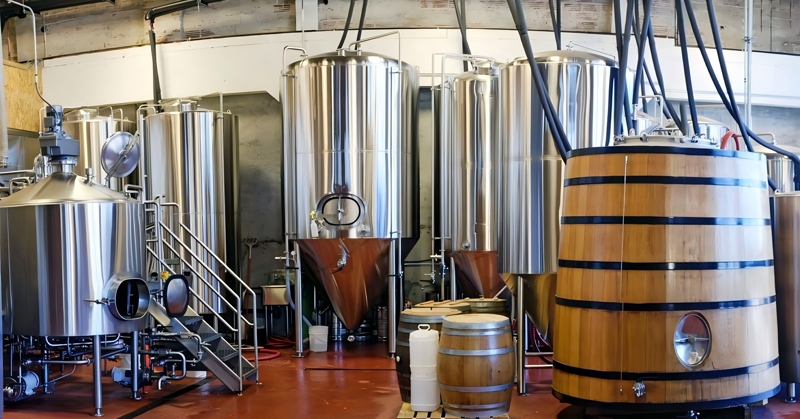How to Setting Up a Craft Brewery
Setting up a craft brewery goes beyond wanting to start a business; it requires a thorough grasp of the current industry landscape. The craft beer movement has grown substantially, characterized by innovative flavors, sustainable practices, and a strong sense of community. Brewers today are artisans and guardians of a rich tradition, balancing creativity with quality and consistency. While there is room for artistic expression, modern breweries must also navigate a complex regulatory environment to ensure local and federal law compliance.
This essential checklist for setting up a craft brewery will equip you with the necessary knowledge and tools to turn your vision into a thriving business. From sourcing quality ingredients to optimizing production processes and building a loyal customer base, each step is vital in developing a brewery that thrives in a competitive market.
1.Conduct Thorough Market Research
In the craft beer industry, conducting exhaustive market research is critical for any budding brewery. Understanding your target demographic is essential—you must identify who your consumers are, what flavors and styles appeal to them, and how their preferences are shifting. The goal is to create products that resonate with your intended audience and stand out in a crowded marketplace.
It is also essential to scrutinize your competitors and broader market trends. This involves identifying existing players, their strengths, weaknesses, and the niches they occupy. Finding gaps in the market or emerging trends can offer your brewery a competitive edge, allowing you to introduce products that fulfill unaddressed demands.
2.Develop a Solid Business Plan
Creating a strong business plan is indispensable in executing your craft brewery. This comprehensive document acts as a blueprint, laying the foundational framework for your brewery’s development and ensuring that every action aligns with your overarching goals. The plan should begin with a detailed company overview, stating your mission, vision, and core values.
You must also delve into market analysis, providing insights into industry trends, consumer preferences, and competitor landscapes. This allows you to highlight your target audience, market positioning, and unique value propositions, outlining how your brewery intends to differentiate itself in a saturated market. This section is the spine of your strategy, guiding decisions from product development to marketing tactics.
3.Secure Financing and Funding
Establishing a craft brewery demands a substantial financial commitment, requiring careful planning and resourcefulness in securing the necessary capital. Evaluate your financial readiness by assessing your personal savings and determining how much you can afford to invest without compromising your financial security.
For those seeking alternative funding sources, consider exploring government grants or industry-specific funding programs that support small businesses and innovative startups. These grants often have specific criteria, so ensuring your brewery meets all applicable objectives is essential. Each option requires a strategic approach to balance risk and opportunity while laying a foundation for sustainable growth.
4.Choose an Ideal Location
Selecting the ideal location for your craft brewery is a pivotal decision that impacts every aspect of your business, from distribution logistics to customer accessibility. An optimal site should balance cost efficiency with strategic placement to attract customers and streamline operations.
You can benefit from a location with high foot traffic that draws visitors to an on-site taproom, allowing you to boost brand visibility and engage directly with your target demographic. Furthermore, close proximity to complementary businesses, such as restaurants or entertainment venues, can create a symbiotic relationship that benefits all parties.
5.Obtain Necessary Permits and Licenses
Navigating the regulatory environment is a foundational step in establishing a craft brewery. This requires a comprehensive understanding of the various permits and licenses essential for legal operation. At the federal level, the Alcohol and Tobacco Tax and Trade Bureau (TTB) mandates a Brewer’s Notice before production can commence.
This permit is critical as it controls the lawful production and distribution of alcohol. Compiling detailed documentation outlining your business structure, ownership details, and operational plans is vital to expedite the application process.
6.Invest in Brewing Equipment
Investing in quality commercial brewing equipment is crucial for the consistency, efficiency, and overall success of your craft brewery operation. The right equipment ensures the production of high-quality beer and significantly affects the scalability and sustainability of your brewing processes.
When selecting equipment, consider your brewery’s unique needs, including production scale, budget constraints, and the physical layout of your facility. High-grade brewing systems, such as fermenters, brew kettles, mixing tanks, and keg washers, provide the durability and precision required to maintain consistent product quality.
7.Design the Brewery Layout
Crafting an effective brewery layout is critical to any successful operation, directly influencing productivity, safety, and the overall customer experience. A meticulously designed layout begins with mapping out an efficient workflow that minimizes labor intensity and enhances operational efficacy. This involves strategically placing brewing equipment to streamline processes, from raw ingredient storage to final product packaging.
You should prioritize accessibility and ergonomic principles with equipment such as brewing kettles, fermentation tanks, and cleaning stations. Their placement should reduce unnecessary movement and facilitate seamless transitions between brewing stages. The space should also accommodate raw materials and finished products, ensuring that supplies are available when needed without overcrowding workspaces.
8.Develop Unique and High-Quality Recipes
Crafting unique and high-quality beer recipes can distinguish your brewery in a competitive market. Begin by exploring various flavors and ingredients, considering traditional brewing elements and unconventional additions that could elevate your beer’s profile.
Incorporating local ingredients supports nearby producers and instills a sense of regional authenticity and exclusivity in your brews. However, thorough research and experimentation are crucial to understanding the complexities of ingredient interactions. Carefully selecting and combining malt, hops, and yeast will influence your beer’s color, taste, aroma, and body, defining its unique character.
9.Create an Engaging Brand Image
Developing an engaging brand image will help your brewery stand out and build a lasting consumer connection. Your brand should reflect your brewery’s mission, values, and unique selling propositions, creating a compelling narrative that resonates with your target audience.
Begin by clearly defining your brand identity, including what makes your brewery different, the story behind its inception, and the passion driving your beer creations. This story should be consistent across all customer interaction points, from your logo and packaging to the ambience of your taproom.
Setting up a craft brewery demands passion, creativity, and strategic planning. The craft beer industry is as competitive as it is rewarding, fostering innovation and community connection. The essence of a successful brewery is not merely its ability to produce quality beer but also its capacity to tell a compelling story that resonates with its audience.
With an innovative spirit and knowledge of market trends, your craft brewery can evolve with the industry, staying ahead of the curve. By committing to excellence, your brewery can become an influential business in the market, delighting customers with every pour and establishing a legacy of creativity and quality.
Post time: May-15-2025



